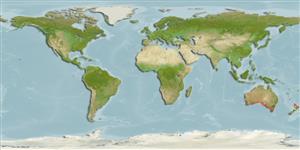Environment: milieu / climate zone / depth range / distribution range
पारिस्थितिकी
समुद्री ड़िमरसल; गहराई सीमा ? - 60 m (Ref. 33616). Temperate; 28°S - 43°S
Eastern Indian Ocean: southern Australia, from Western Australia to New South Wales and Tasmania.
आकार / वज़न / Age
Maturity: Lm ? range ? - ? cm
Max length : 20.0 cm SL पुल्लिंग / अलिंग; (Ref. 33616)
Short description
पहचान कुंजी | आकृति विज्ञान | मौरफोमैटरिक्स
पृष्ठीय रीढ़ (सम्पूर्ण) : 8 - 9; पृष्ठीय सौफट रेज़ (सम्पूर्ण) : 13 - 15; गुदा कांटा: 0; ऐनल सौफट रेज़: 13 - 15; जानवरों की रीड़ का जोड़: 30 - 31. Adults have scute-like lateral line scales, a prominent white-edged dark blotch on the first dorsal fin, a broad pale band on the caudal fin, and blackish green color on the inner surface of the large pectoral fins (Ref. 33616).
Found in bays and coastal marine waters, over the continental shelf (Ref. 33616).
Life cycle and mating behavior
परिपक्व अवधि | पुनरुत्पत्ति | मछलीऔ का अंडे देना | अंडे | Fecundity | लार्वा
Neira, F.J., A.G. Miskiewicz and T. Trnski, 1998. Larvae of temperate Australian fishes: laboratory guide for larval fish identification. University of Western Australia Press. 474 p. (Ref. 33616)
IUCN Red List Status (Ref. 130435: Version 2024-1)
Threat to humans
Harmless
Human uses
मात्स्यिकी: कोई रुचि बग़ैर
साधन
Special reports
Download XML
इंटरनेट स्रोत
Estimates based on models
Preferred temperature (Ref.
123201): 15.1 - 19.6, mean 17.1 °C (based on 124 cells).
Phylogenetic diversity index (Ref.
82804): PD
50 = 0.5000 [Uniqueness, from 0.5 = low to 2.0 = high].
Bayesian length-weight: a=0.00676 (0.00325 - 0.01404), b=3.05 (2.87 - 3.23), in cm total length, based on LWR estimates for this (Sub)family-body shape (Ref.
93245).
Trophic level (Ref.
69278): 3.5 ±0.3 se; based on size and trophs of closest relatives
लौटाव (Ref.
120179): माध्यम, न्यूनतम जनसंख्या दुगनी होने का समय 1.4 - 4.4 वर्ष। (Preliminary K or Fecundity.).
Fishing Vulnerability (Ref.
59153): Low vulnerability (14 of 100).
